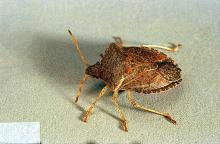Includes consperse stink bug (Euschistus conspersus)
Pest description and crop damage Large, bright-green bugs, shield-shaped and flattened. They have a foul odor and may contaminate berries at harvest. The machine harvester can shake insects from the plants, potentially contaminating berries going into the harvest trays.
Management-cultural controls
Correct adjustment of air-blast or vacuum-suction cleaner systems on mechanical harvesters can lessen insect contamination of machine-picked berries.
Management-chemical control: HOME USE
- azadirachtin/ neem oil-Some formulations are OMRI-listed for organic use.
- bifenthrin
- carbaryl
- esfenvalerate
- horticultural oils
- permethrin-For use on raspberry only.
- plant essential oils (cinnamon, clove, garlic, peppermint, rosemary, thyme)-Some formulations are OMRI-listed for organic use.
- pyrethrins-Some formulations are OMRI-listed for organic use.
- zeta-cypermethrin
Management-chemical control: COMMERCIAL USE
Products applied for leafroller control before harvest (such as: bifenthrin, esfenvalerate, fenpropathrin, malathion, and zeta-cypermethrin) may provide some control of stink bugs. Insecticides registered specifically for stink bugs include:
- fenthropathrin (Danitol 2.4EC) at 0.2 to 0.3 lb ai/A. PHI 3 days. Highly toxic to bees-do not apply during bloom. Restricted use pesticide.
- pyrethrins (PyGanic and others)-Consult label for rate. PHI 0 days. Some formulations OMRI-listed for organic use.
- thiamethoxam (Actara) at 0.047 lb ai/A. PHI 3 days. Highly toxic to bees-do not apply during bloom.

